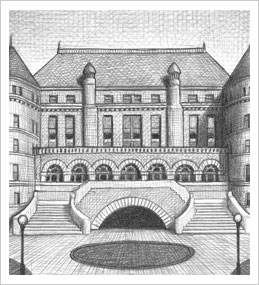The History of Dioramas at the American Museum of Natural History
By Steve Quinn

Habitat Dioramas in natural history museums are a unique example of art in the service of science. They are art installations intended to create an illusion of the physical world to evoke a wonder of and a communion with nature.
As an art form they have their origins with the theatrical cycloramas, panoramas and dioramas of the 19th century. Their appearance in natural history museums coincides with the great environmental calamities and species extinctions of that same period and were, at the American Museum of Natural History in New York City, the chosen medium to urge for laws and regulations to protect vanishing wildlife and threatened natural resources. They were powerful tools that proceeded the advent of sophisticated wildlife photography, motion pictures, television and computer technologies and can be considered an early form of virtual reality intended to nurture environmental awareness and concern.
When they depict actual locations, as many do at the American Museum of Natural History, they have great relevance to us today as they serve as a record of the environment at a specific site at a moment in time. Each site can be revisited today using the diorama and the scene depicted in it’s background painting to document the habitat change that has occurred over the years since the dioramas creation. In some cases the dioramas demonstrate great conservation success stories where regions depicted have become national parks or wildlife preserves. Some of these successes are the result of being displayed as a subject in these dioramas. Others serve as a record of a region before we, as a species destroyed it, whether that be by transforming the landscape through farming or development or by eliminating the species of wildlife that serves as the dioramas central focus. Both of these scenarios tell critically important stories from which we must learn for the future.
The artists who worked to create these exhibits immersed themselves in the science and details of the natural world depicted in each scene, so much so that they themselves became great naturalists and experts in their subject matter. They often fabricated a small-scale model of the finished diorama on location to provide direction for the artist team and define their goals during the expedition. The background paintings are based on plein air sketches done at each site as well as thorough photographic documentation. This data is then brought back to the museum and utilized in the creation of a larger life-sized curved background mural, which utilizes mathematical calculations and a transfer grid to assure an undistorted view of nature on the curved canvas. The mounted specimens are exact replicas of individual animals collected as scientific specimens at the location and carefully measured and documented with photographs, paintings, and plaster masks to provide reference for the final sculpture of each animal over which the hide of that specific specimen would be mounted. All of the three dimensional objects appearing in the foreground of the diorama, other that the animal specimens, must also be documented and collected. Soil, rocks, grasses, and references for the recreation of all plant-life and trees found in the scene must brought back to the museum for the recreation of the terrain and all the leaves and flowers required.
Each diorama depicts a scientifically accurate ecosystem at a moment during a specific year, month and time of day.
Considering this remarkable dedication on the part of museum artists to be faithful and true to nature in their work , it is no surprise that Brian’s character Ben is “Wonderstruck” at an early age by his encounter with the wolf diorama when he first sees it at museum and that memory and wonder stays with him and aids him in discovering who his father was and his dedication to recreating nature for the wonder and appreciation of others.
Naturalist and artist Stephen C. Quinn joined the staff of the American Museum of Natural History in 1974. His first assignment was as a foreground artist for the Wood Stork diorama in the Hall of North American Birds. In his current capacity as Senior Project Manager for Exhibitions at the museum, he oversees all aspects of new diorama creation—including field expeditions, exhibit fabrication, and installation—as well as diorama conservation and restoration. Mr. Quinn provided the illustrations for the 1994 book What Color is That Dinosaur? by Lowell Dingus, and was co-author of Inside the Dzanga-Sangha Rain Forest (1998) and author of Windows on Nature: The Great Habitat Dioramas of the American Museum of Natural History (2006).